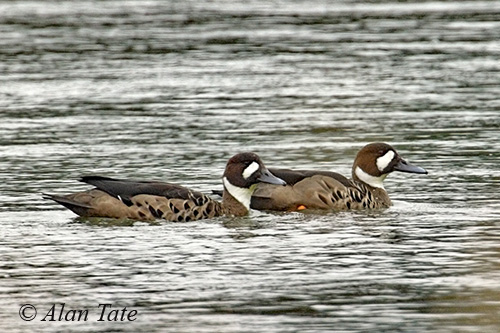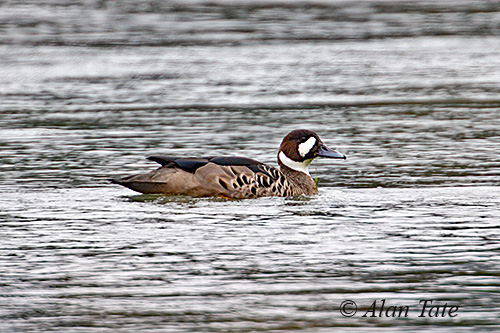
Fr: Canard à lunettes
Ang: Spectacled Duck - Bronze-winged Duck
All: Kupferspiegelente
Esp: Ánade Anteojillo
Ita: Anatra dagli occhiali
Nd: Bronsvleugeleend
Sd: bronsvingad and
Photographers:
Jean-Claude Billonneau
Photographe-témoin de la Beauté du Monde
Eduardo Andrés Jordan
MIS AVES – AVES DE ARGENTINA
Alan & Ann Tate
AA Bird Photography
Text by Nicole Bouglouan
Sources:
HANDBOOK OF THE BIRDS OF THE WORLD vol 1 by Josep del Hoyo-Andrew Elliot-Jordi Sargatal - Lynx Edicions - ISBN: 8487334105
GUIDE DES CANARDS, DES OIES ET DES CYGNES – de Steve Madge - Delachaux et Niestlé - ISBN: 2603013769
A Guide to Wildfowl & Photography at Slimbridge Wetland Centre
Arthur Grosset's Birds (Arthur Grosset)
Wikipedia, the free encyclopaedia
Bronze-winged Duck or Spectacled Duck
Speculanas specularis
Anseriformes Order – Anatidae Family
INTRODUCTION:
The Bronze-winged Duck or Spectacled Duck is the sole member of the genus Speculanas, because it is quite distinct from the dabbling ducks of the genus Anas where it was usually placed. The two closest relatives are the Crested Duck and the Brazilian Teal.
The Bronze-winged Duck is found in S Chile and WC Argentina, S to Tierra del Fuego. It frequents forests and woodlands close to fast-flowing water, but it can also be seen on lakes and ponds.
It feeds on aquatic animals, vegetation, seeds, small fish, snails and crabs, and forages at water edge by wading, probing and grazing.
The species typically nests on the ground among the low vegetation. They are monogamous and territorial all year round.
The Bronze-winged Duck is affected by predation by American Mink and disturbance caused by tourism in National Parks, but also by salmon farming and trout stocking on Chilean rivers.
The global population is fairly small, and the species is currently classified as Near Threatened.

DESCRIPTION OF THE BIRD:
Biometrics:
Length: 46-54 cm
Weight: M: 1130-1460 g – F: 900-1070 g
On the upperparts, the Bronze-winged Duck has dark brown/blackish mantle and scapulars with paler fringes. The uppertail is dark brown. The upperwing is dark brown to purplish black. We can see an iridescent bronzy-pinkish speculum, with narrow black and white lines on the trailing edge.
The underparts, including the breast, are greyish-brown with buff and dark brown barring or mottling. This pattern changes on the flanks where it becomes large, dark brown or blackish crescents. On the underwing, the white axillaries and the partial trailing edge contrast with the dark flight-feathers. This pattern is conspicuous in flight.
On the dark brown head, there is a conspicuous white oval patch in front of the eye, and a second white patch on the throat extending up to the neck sides, like a semi-collar.
The bill is bluish-grey with black tip and culmen. The eyes are dark brown. Legs and webbed feet are yellow to yellow-orange.
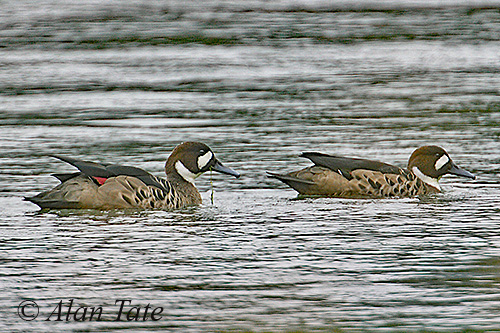
Male and female are similar, but the female is smaller with slightly duller plumage.
The juvenile shows smaller, white patch on the head, but this feature may be absent. The plumage is duller, with heavily streaked breast.
RANGE:
The Bronze-winged Duck is found in S Chile and WC Argentina, S to Tierra del Fuego.
HABITAT:
The Bronze-winged Duck often lives close to fast-flowing water, usually in or close to woodland. It also frequents lakes, ponds, pools and marshes adjacent to forested areas. This species is common below 1,500 metres of elevation.
CALLS AND SONGS: SOUNDS BY XENO-CANTO
The Bronze-winged Duck female produces a bark-like call described as a repeated, descending, raucous 5-6 syllable quacking sound, accompanied by a loud guttural note. This call is given when the female incites the male to copulation.
The male replies to this call with a trilled, piercing whistle, prior to copulation.
This species is also named “pato-perro” or “dog-duck” after the harsh, barking call of the female.
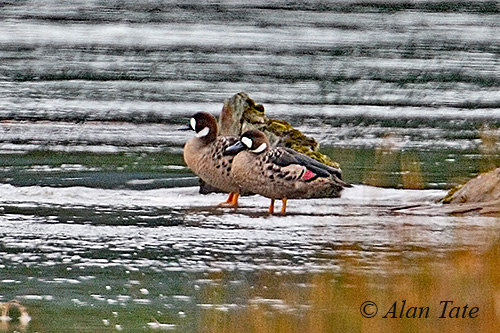
BEHAVIOUR IN THE WILD:
The Bronze-winged Duck consumes both vegetable and animal food items. The diet includes stems of Water Crowfoot of Genus Batrachium and also Water Milfoil of Genus Myriophyllum. It also takes foliage and seeds of pondweeds, roots, and a variable amount of aquatic invertebrates such as insects and their larvae and molluscs. This species has been observed eating small snails on stony shingle beaches.
The Bronze-winged Duck often forages in pairs or in small groups. They feed by wading in shallow water, probing and grazing at water edge. It occasionally upends in shallow water.
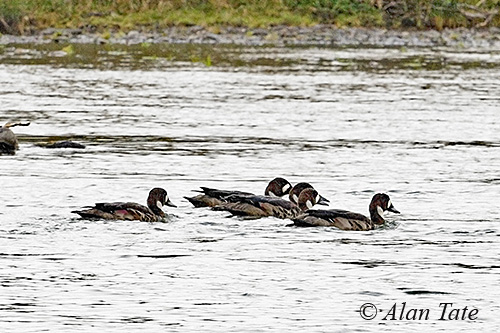
The Bronze-winged Duck is territorial almost all year round, and defends both foraging and breeding territories.
They are monogamous with probably long-term pair bonds.
Prior to copulation, the female encourages the male to mate with a distinctive, repeated barking call. She performs strong chin-lifting movements in order to expose the white throat patch. The male responds with vigorous diagonal neck stretching and chin-lifting, during which the nape may sometimes touch the back. These displays are accompanied by calling.
Small populations are suspected to disperse north and east outside of breeding season. Most of them migrate N and E to C Chile and C Argentina during the austral winter.
The Bronze-winged Duck rarely flies high in the air, even if disturbed or flushed. It follows the meanders of the rivers.
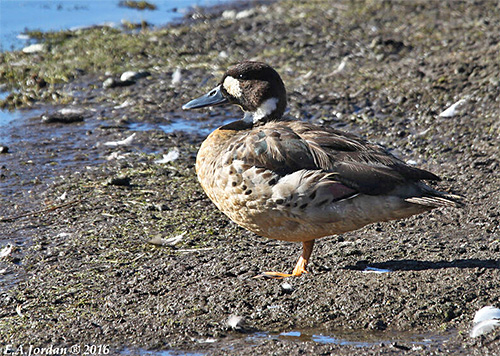
REPRODUCTION OF THIS SPECIES:
The breeding season takes place from September/October, with the laying in October/November. The chicks hatch in late December/early January.
The Bronze-winged Duck is solitary nester. The nest is on the ground, usually in the low vegetation. The nesting site is often in forested areas near fast-flowing rivers. It may be also on wetlands, ponds and lakes, up to 1,800 metres of elevation, and on river islets when available.
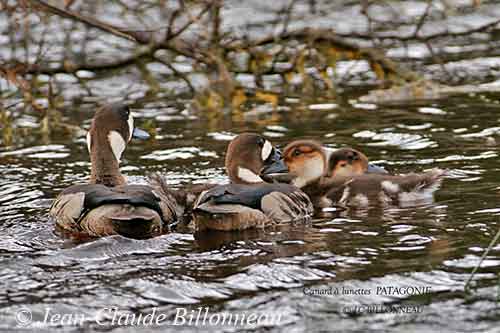
The female lays 4-7 cream-coloured eggs. The incubation lasts about a month, by the female alone.
At hatching, the chicks have black and cinnamon down above, whereas the underparts are whitish-yellow. On the head, we can see a black spot on the cheek. The face is pale yellowish with a dark eyestripe. The bare parts are black.
The fledging period is unknown. Both adults care for and protect them for some time after fledging.
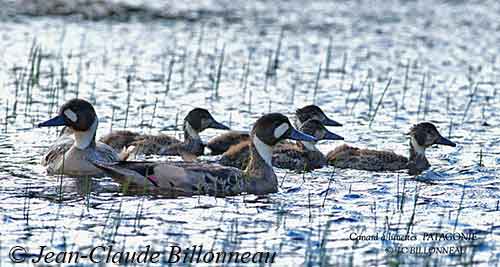
PROTECTION / THREATS / STATUS:
The Bronze-winged Duck is threatened by predation by Mustela vison. It is also affected by salmon farming and trout stocking on Chilean rivers.
The species is relatively common in protected areas such as National Parks in Argentina. However, the Bronze-winged Duck undergoes an increasing pressure from tourism, especially in Los Glaciares National Park.
The small population is estimated to number 1,500/7,000 mature individuals. It is suspected to be stable at the moment.
But currently, the Bronze-winged Duck is classified as Near Threatened.
